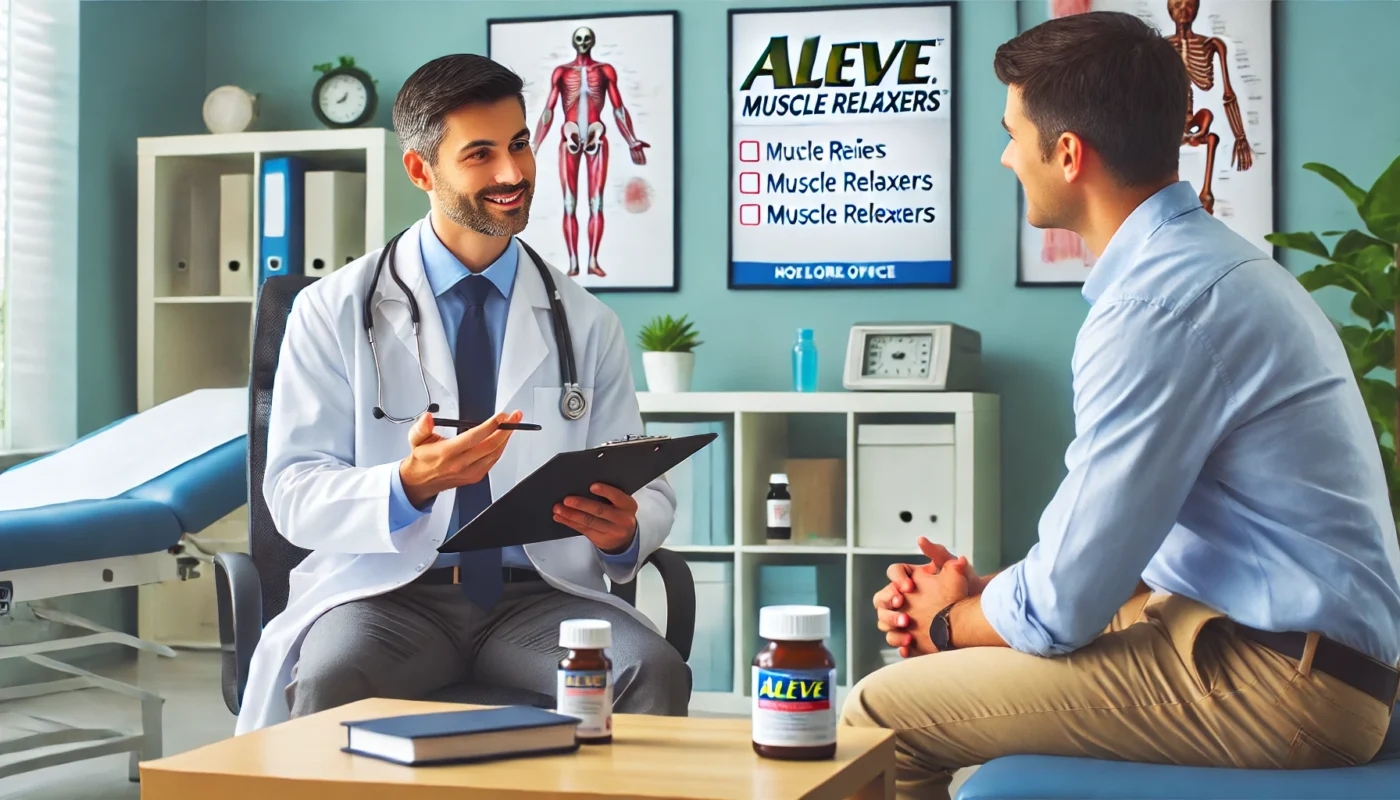Aleve, known generically as naproxen, is a nonsteroidal anti-inflammatory drug (NSAID). It’s commonly used for reducing inflammation and alleviating pain. As an over-the-counter medication, Aleve is accessible for those seeking relief from mild to moderate pain, including back pain. Let’s delve deeper into how Aleve functions and its implications for muscle pain.
You may also like: Understanding Long-Term Pain Relief Options
How Aleve Works
Aleve operates by inhibiting enzymes known as COX-1 and COX-2. These enzymes are pivotal in the production of prostaglandins, chemicals that play a significant role in promoting inflammation, pain, and fever. By reducing the production of prostaglandins, Aleve effectively decreases inflammation and alleviates pain.
This inhibition process is crucial because prostaglandins not only contribute to inflammation and pain but also protect the stomach lining and support platelet function. Thus, while Aleve reduces pain, it also underscores the importance of cautious use to prevent potential gastrointestinal issues. Understanding the dual role of prostaglandins helps in comprehending why Aleve is effective yet necessitates careful consumption.
Aleve’s Effectiveness on Muscle Pain
While Aleve is effective for general pain relief, many wonder: is Aleve good for muscle pain? Aleve can indeed help with sore muscles by reducing inflammation. However, it is not specifically a muscle relaxer. It does not directly address muscle spasms but rather alleviates the associated pain and inflammation.
Aleve’s strength lies in its ability to manage pain stemming from inflammation, making it ideal for injuries or conditions like arthritis. Its action on inflammation means it can reduce swelling and discomfort, allowing for better mobility. However, when muscle spasms are the primary concern, Aleve may only offer partial relief, emphasizing the need for a more targeted approach.
Potential Side Effects of Aleve
Taking Aleve for back and muscle pain is generally safe when used as directed. Nonetheless, it may lead to side effects such as stomach upset, heartburn, headache, dizziness, and in some cases, more severe gastrointestinal issues. It’s crucial to consult with a healthcare professional if you experience any adverse effects.
Long-term use or high dosages of Aleve can increase the risk of cardiovascular issues, underscoring the importance of adhering to recommended dosages. Additionally, individuals with pre-existing conditions such as ulcers or kidney issues should exercise caution. Being informed about these potential risks allows for better decision-making and safer pain management.
Exploring Muscle Relaxers for Back Pain
Muscle relaxers are a class of medications designed specifically to alleviate muscle spasms. These drugs work on the central nervous system to reduce muscle tension and discomfort. Let’s explore how muscle relaxers function, their common types, and their effectiveness.
How Muscle Relaxers Work
Muscle relaxers function by targeting the central nervous system. Unlike Aleve, they do not address inflammation but instead act as central depressants, reducing the nerve signals that cause muscles to tighten and spasm.
This central mechanism allows muscle relaxers to directly alleviate muscle tension, providing relief from spasms. By calming the central nervous system, they help in relaxing tight muscles, offering immediate comfort. This makes them particularly effective for acute muscle spasms or injuries where muscle tension is the primary issue.
Commonly Used Muscle Relaxers
Several muscle relaxers are available, both over the counter and by prescription. While prescription muscle relaxers like cyclobenzaprine and methocarbamol are well-known, there are also over-the-counter options for muscle relaxers for back pain. However, these OTC options are typically less potent and may not provide the same level of relief as prescription medications.
Prescription muscle relaxers are often favored for their potency and effectiveness in severe cases. However, they come with a higher risk of side effects, including drowsiness and dependency. OTC options, while milder, offer an alternative for those with mild symptoms. Understanding the spectrum of muscle relaxers helps in choosing the most suitable option based on severity and individual needs.
Are Muscle Relaxers Effective?
For those experiencing acute back muscle spasms, muscle relaxers can be highly effective. They provide direct relief by calming the muscles, thereby alleviating pain and discomfort. However, they may cause side effects such as drowsiness, dizziness, and dry mouth.
The effectiveness of muscle relaxers hinges on their ability to interrupt the cycle of pain and tension, allowing the body to heal. Despite their efficacy, the side effects necessitate cautious use, particularly for those who need to remain alert during their daily activities. Assessing the balance between relief and potential side effects is key to optimizing their use.
Comparing Aleve and Muscle Relaxers
Key Differences
The primary distinction between Aleve and muscle relaxers lies in their mechanisms of action. Aleve targets inflammation and pain through the inhibition of prostaglandins, while muscle relaxers focus on reducing muscle spasms through central nervous system depression. This fundamental difference means that Aleve is better suited for inflammatory conditions, whereas muscle relaxers excel in treating muscle spasms.

Understanding these mechanisms helps in identifying the root cause of pain and choosing the appropriate treatment. For individuals with overlapping symptoms of inflammation and spasms, recognizing these differences is crucial for effective relief. This knowledge empowers patients to make informed decisions about their pain management strategies.
Situational Use
Choosing between Aleve and a muscle relaxer depends on the nature of your pain. If your back pain stems primarily from inflammation, Aleve might be more appropriate. Conversely, if muscle spasms are the primary issue, a muscle relaxer may offer more direct relief.
Situational use emphasizes the importance of symptom assessment. Evaluating the intensity, duration, and type of pain guides the selection process. In some cases, initial use of one medication followed by the other might be necessary, especially when pain evolves or when addressing multiple symptoms.

Can Aleve and Muscle Relaxers Be Used Together?
In certain situations, healthcare providers may recommend using both Aleve and a muscle relaxer concurrently. This combination can provide comprehensive relief by addressing both inflammation and muscle spasms. However, it’s crucial to consult with a healthcare provider before combining these medications to avoid potential interactions and side effects.
The combination therapy approach leverages the strengths of both medications, offering a broader spectrum of relief. However, it requires careful monitoring to avoid adverse effects and ensure compatibility. Healthcare professionals can provide guidance on dosage and timing to maximize benefits while minimizing risks.
Practical Advice for Choosing the Right Medication
Consult with a Healthcare Professional
Always seek the guidance of a healthcare professional when selecting a medication regimen. They can offer personalized advice based on your medical history and specific symptoms.
Healthcare professionals can help in evaluating the potential benefits and risks associated with each option. Their expertise ensures that medication choices align with individual health conditions and treatment goals. Regular consultations facilitate adjustments in treatment as symptoms evolve.
Consider Non-Pharmacological Alternatives
In addition to medication, consider incorporating holistic approaches such as physical therapy, acupuncture, yoga, or massage into your treatment plan. These modalities can complement the effects of medication and promote overall wellness.
Non-pharmacological alternatives offer a holistic approach to pain management, addressing not just symptoms but also underlying causes. These methods can enhance flexibility, reduce stress, and improve overall quality of life. Integrating such approaches fosters a balanced treatment plan that supports long-term health.
Monitor and Adjust Your Treatment
Pay attention to how your body responds to different treatments. Adjust your approach as needed, and keep your healthcare provider informed of any changes in your symptoms or side effects.
Monitoring treatment effectiveness is crucial for achieving optimal outcomes. Regularly assessing pain levels and side effects helps in fine-tuning medication regimens. Open communication with healthcare providers ensures that any necessary adjustments are made promptly, maintaining the efficacy of the treatment plan.

Conclusion
Understanding the differences between Aleve and muscle relaxers is essential for making informed decisions about back pain management. Each medication has its own strengths and is suited to different types of pain. By consulting with healthcare professionals and considering a holistic approach, you can create a personalized strategy that effectively addresses your specific needs and enhances your overall wellbeing.
Recognizing the unique roles of Aleve and muscle relaxers allows for tailored treatment approaches. This understanding is the foundation for effective pain management, aligning treatment choices with individual health goals. A comprehensive approach, incorporating both medical and non-medical strategies, ensures a more resilient and adaptable pain management plan.
Further Reading:
Advil vs. Aleve vs. Tylenol: What’s the Difference?
Muscle Relaxers: Best Over-The-Counter and Rx Options
Aleve, muscle relaxers, pain management, back pain, inflammation, NSAIDs, muscle spasms, healthcare, medication, non-pharmacological alternatives, side effects, treatment options, holistic approaches, physical therapy, acupuncture, yoga, massage
Important Note: The information contained in this article is for general informational purposes only, and should not be construed as health or medical advice, nor is it intended to diagnose, prevent, treat, or cure any disease or health condition. Before embarking on any diet, fitness regimen, or program of nutritional supplementation, it is advisable to consult your healthcare professional in order to determine its safety and probable efficacy in terms of your individual state of health.
Regarding Nutritional Supplements Or Other Non-Prescription Health Products: If any nutritional supplements or other non-prescription health products are mentioned in the foregoing article, any claims or statements made about them have not been evaluated by the U.S. Food and Drug Administration, and such nutritional supplements or other health products are not intended to diagnose, treat, cure, or prevent any disease.

